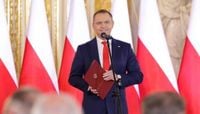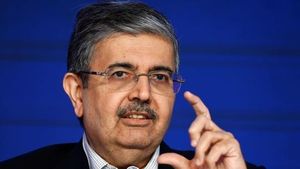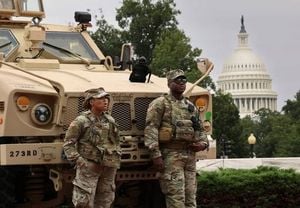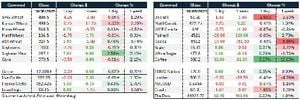On August 6, 2025, Karol Nawrocki officially assumed the office of President of Poland, stepping into a role that carries immense weight in both European and transatlantic politics. His inauguration, which took place before the National Assembly of Poland, was a ceremony marked by the presence of former presidents, the prime minister, and other high-ranking officials. But Nawrocki’s first days in office have already set the stage for significant international developments, particularly in the context of Polish–U.S. relations and the broader regional landscape.
One of the most immediate and high-profile gestures came from across the Atlantic. According to reports from UNN and Reuters, U.S. President Donald Trump wasted no time in reaching out to the new Polish leader. In an official congratulatory letter delivered on the very day of Nawrocki’s inauguration, Trump invited the Polish president to the White House for an official working meeting scheduled for September 3, 2025. The invitation, as confirmed by Pawel Szefernaker, the head of Nawrocki’s cabinet, was swiftly publicized and has since become a focal point of diplomatic anticipation.
This invitation is more than a mere formality. It signals the continuation—and possibly the strengthening—of a relationship that Nawrocki has consistently described as vital. Throughout his campaign and in public remarks, Nawrocki has emphasized the importance of good Polish–U.S. relations. As Reuters noted, Nawrocki’s campaign was notably supported by Poland’s main nationalist opposition party, Law and Justice, a faction known for its strong pro-American stance. In a telling episode just before the Polish election in May, Nawrocki met with Trump in the Oval Office and received the U.S. leader’s endorsement—an event that underscored both leaders’ mutual interest in close cooperation.
For those watching Poland’s domestic scene, Nawrocki’s rise comes at a time of acute political division. Yet, as Polish international affairs expert Michał Kuź told Ukrinform, Nawrocki and Prime Minister Donald Tusk “have more points of contact than differences on key foreign policy and security issues.” Kuź specifically pointed to their shared views on three major fronts: viewing Russia as the primary threat to Poland’s security, treating NATO as the main guarantor of that security, and supporting the ongoing development of the Polish military. These areas of consensus, Kuź argued, are likely to help maintain a steady course in Poland’s foreign policy despite any domestic turbulence.
Still, there are nuances to consider. While Nawrocki is seen as more focused on cooperation with the U.S., Tusk’s orientation is toward Germany and the Weimar Triangle—a regional partnership among Poland, Germany, and France. The recent signing of a trade agreement between the EU and the U.S. is expected to further blur any differences, but it’s clear that Nawrocki’s presidency will bring a distinct emphasis to Poland’s international posture.
One area where Nawrocki is expected to make his mark is in historical policy, especially regarding Poland’s complex relationship with Ukraine. As a historian who previously headed the Institute of National Remembrance, Nawrocki has already signaled a shift in how Poland will approach issues such as the search and exhumation of victims in Volyn—a region with a painful shared history for both nations. Kuź explained, “He will defend Ukraine’s independence, but if we want closer ties and a policy of closer Polish–Ukrainian cooperation, then we must resolve the issue of exhumations in a mutually beneficial way.” Otherwise, Kuź warned, the relationship risks becoming “a cool friendship or a marriage of convenience, but without any deeper cooperation or deeper understanding.”
This sentiment was echoed by Marcin Przydacz, the Head of the International Policy Bureau at the Chancellery of the President of the Republic of Poland, who stated that Nawrocki will indeed support Ukraine—particularly in the context of military aid and countering Russian aggression—but that such aid will not be unconditional. Poland, Przydacz emphasized, will attach conditions to its support, especially those that relate to the countries’ intertwined and sometimes contentious histories.
The importance of these historical issues cannot be overstated, especially given the ongoing war in Ukraine and the strategic role that Poland plays as a logistical hub for military and humanitarian support. While Nawrocki’s administration is not expected to make radical changes to the current trajectory of Polish–Ukrainian relations, the shift in emphasis could have significant implications for how both countries navigate their shared past and future cooperation.
Meanwhile, the upcoming meeting between Nawrocki and Trump is being closely watched by analysts and officials on both sides of the Atlantic. For Trump, the invitation is a chance to reaffirm U.S. commitment to its Eastern European allies and to signal continuity in American foreign policy, even as global dynamics remain in flux. For Nawrocki, the visit will be an opportunity to solidify his standing as a leader who values strong transatlantic ties and to perhaps secure further U.S. support for Poland’s security and defense priorities.
The context of this meeting is further enriched by Nawrocki’s recent electoral victory. According to the National Electoral Commission of Poland, Nawrocki won the presidential election with almost 51% of the vote—a slim but decisive margin that reflects both the competitiveness of Polish politics and the mandate he now carries. His inauguration was attended by a broad spectrum of political figures, underscoring the significance of the transition and the expectations placed upon him as Poland’s new head of state.
As September approaches, the diplomatic choreography intensifies. The White House meeting is set to be more than a ceremonial handshake; it is expected to cover a range of pressing issues, from security cooperation and military aid to the evolving situation in Ukraine and the broader challenges posed by Russia. The stakes are high, and the outcomes could shape not only Polish–U.S. relations but also the security architecture of Central and Eastern Europe for years to come.
In the end, Nawrocki’s presidency begins at a moment of both opportunity and uncertainty. With a clear mandate, strong backing from key political forces, and a commitment to maintaining Poland’s pivotal role on the international stage, Nawrocki has signaled his intent to navigate these challenges with a steady hand. The invitation from President Trump, delivered on day one, is both a symbol and a test—a chance for Poland’s new leader to demonstrate that he can balance history, alliance, and national interest in a rapidly changing world.
As the world watches, all eyes are now on Warsaw and Washington, awaiting the results of a meeting that could set the tone for the next chapter in Polish–American relations.




